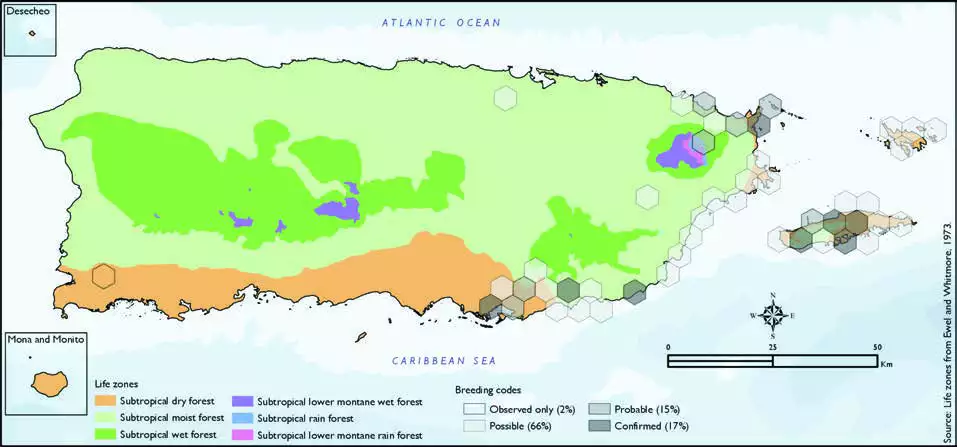Antillean Crested Hummingbird
Description
The Antillean crested hummingbird (Orthorhyncus cristatus) is a species of hummingbird in the family Trochilidae. Found across Anguilla, Antigua and Barbuda, Barbados, Dominica, Grenada, Guadeloupe, Martinique, Montserrat, north-east Puerto Rico, Saba, Saint-Barthélemy, Saint Kitts and Nevis, Saint Lucia, Saint Martin, Saint Vincent and the Grenadines, Sint Eustatius, the British Virgin Islands, the U.S. Virgin Islands, and the Lesser Antilles, while it has also been recorded as a vagrant in Florida, USA.
As the name implies, Antillean crested hummingbird is one of the few hummingbirds with a crest. It demonstrates the general sexual dimorphism for hummingbirds where the male is bright and colorful whilst the female is more tannish and dull.[11] Males have a short straight black bill; head with green crest, tipped metallic green to bright blue-green, upperparts dull metallic bronze-green; underparts sooty black; tail black, rounded. The female bill is similar to male’s but its head is without a crest; the forehead, crown and upperparts are metallic bronzy-green; underparts light grey; tail blackish, rounded, four outer rectrices broadly tipped whitish grey.
Distribution & Habitat
The Antillean Crested Hummingbird is a common
resident throughout the Lesser
Antilles, the Virgin Islands, and
Puerto Rico (Raffaele and others
1998), principally on the eastern
coast of the island including
Culebra (Ventosa-Febles and others 2005) and Vieques
(Gemmill 2015). The species is
believed to be a relatively recent
arrival from the Virgin Islands
and the Lesser Antilles. First
documented with a specimen
from Vieques in 1912 (Wetmore
1916), it was not found on
mainland Puerto Rico in 1875
1876 by Gundlach (1878) nor in
19111912 by Wetmore (1916,
1917), who was skeptical of
reports of the species occurrence
on the main island. Even as
late as 1950, the species was
described as being of doubtful
occurrence on Puerto Rico but
by 1960 it was recognized as
occurring in eastern Puerto Rico
(Bond 1961, 1967), where it
was believed to be expanding
its range to the south (Raffaele 1989a). This species mostly
occurs in lowland openings,
developed areas, gardens, forest
edges, and especially arid and
dry forests, but also mountain
forests, at least on other islands
(Biaggi 1997, Raffaele and
others 1998, Schuchmann and
Boesman 2020). The atlas
fieldwork yielded a total of 86
records within 47 hexagons or 10
percent of the 479 total hexagons
(see map). Of the 47 hexagons
where this species was found,
breeding met the atlas definition
of confirmed in 17 percent (8) of
the hexagons, probable in 15
percent (7), and possible in 66
percent (31), while the species
was observed in 2 percent
(1) of the hexagons but without
evidence of breeding (see map). Antillean Crested Hummingbird distribution. The map shows the highest breeding code by hexagon and overlaying the ecological
life zones in Puerto Rico. Note: percentages may not total 100 due to rounding. 89Antillean Crested Hummingbird/Zumbadorcito Crestado

Breeding Habits
The Antillean Crested Hummingbird nests in a tiny
cup of cotton or fine fibers
covered with lichens in a tree,
bush, or vine above the ground,
year-round, but primarily from
January to August, according
to previously published reports
(Raffaele and others 1998).
Atlas results indicate that this
species breeding season extends
throughout the year (except for
the atlas data gap in August),
with the most breeding activity
from January through July (see
chart). This seasonal breeding
pattern appears to coincide in each of the life zones with only
a slight indication that breeding
in the driest months (February,
March, April) is reduced relative
to the subtropical moist forest
life zone. Results show that
this species mostly breeds on
the coastal plain within the
subtropical dry forest life zone
(50 percent of the hexagons), the
subtropical moist forest life zone
(48 percent of the hexagons),
and for only one hexagon (2
percent of the hexagons) in
the subtropical rain and lower
montane rain forest life zones
(see table and map).
Conservation
This species is listed as a species of least concern by the IUCN
(BirdLife International 2016),
and locally it is not listed in any
of the threatened categories
used by PRDNER and USFWS.
In Puerto Rico, the Antillean
Crested Hummingbird has a
protected habitat in land of
about 14 percent or 152 km2 of the total area covered by
the hexagons where evidence
of breeding was found for this
species (~1096 km2).
Related Species
Family:
hummingbird